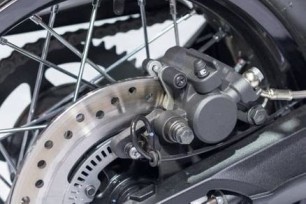Blog Details - Magma HDI

Know about these cool technologies for safe two-wheeler rides 9th November 2021
With increased riders' registrations and two-wheelers plying on the road, motorcycling is becoming more popular in India, thanks to new technologies mainly observed in cars. This digitalization in the automotive industry helps improve fuel efficiency, reduces emissions, and eliminates the possible risk for the two-wheeler and rider.
Manufacturers are steadily researching new technologies to make the bike experience safe. This article will look at a few inventions that have revolutionized how we think about motorcycle safety.
1. Anti-lock Braking System (ABS):
Anti-lock Braking System prevents the wheel(s) of a motorbike from locking up during hard braking. This technology employs speed sensors on both wheels to correctly estimate wheel speed and recognize when a wheel will lock.
This mechanism adjusts the braking pressure to prevent the tyres from locking up and maintain the motorcycle's balance. It also helps to minimize braking distance in several situations. Motorcycles equipped with anti-lock brakes are less likely to meet an accident on the road.
2. Traction Control System (TCS):
Traction control avoids drifting while accelerating on a slippery surface. It limits engine power until the bike can travel without the wheels slipping and provides maximum turning stability.
The sensors and the Electronic Control Unit are the two primary components of a traction control system. The ECU captures data on gravitational forces, lean angles, and other factors. The sensors are constantly updating raw data about the motorcycle's present location. This information helps to adjust the amount of power sent to the back wheels and prevent skidding.
3. Slipper clutch mechanism:
A slipper clutch aims at reducing the effect of engine braking when the rider decelerates. It works by transmitting braking force through the chain drive, making the rear wheel shake and lose traction when the back wheel tries to move the engine quicker than it would under deceleration. The slipper clutch partly disengages the engine until the conditions are suitable for reengaging.
4. Tyre Pressure Monitoring System (TPMS):
This technology works by installing pressure monitoring sensors inside each tyre's valve. These sensors collect data from each tyre, send it to a module that compares it from both tyres and notify the rider if any tyre has low, high, or uneven pressure.
Low tyre pressure can cause slow handling, increasing your chance of meeting an accident. The TPMS technology assists you in avoiding such instances.
5. Ride By Wire technology (RBW):
Ride-by-wire is a new-age acceleration system; it eliminates the need for cables. It's an electronic throttle system that removes the mechanical throttle wire's coupling to the acceleration handlebar. This unique system results in faster and more accurate throttle response.
These cutting-edge technologies are helping bikers with safer riding experiences. As a rider, make sure your bike has these advanced safety features to provide you with a comfortable riding experience and the best possible protection. While you get prepared to upgrade for a bike loaded with these new safety-enhancing features for your bike, also remember to have valid two-wheeler insurance; not only is it necessary, but it is mandatory by the law. Always remember to get ideal 2 wheeler insurance online to improve your safety!
To know about the best 2 wheeler insurance online, click HERE .
Disclaimer: The information provided above is for illustrative purposes only. To get more details, please refer to policy wordings and prospectus before purchasing a policy.

